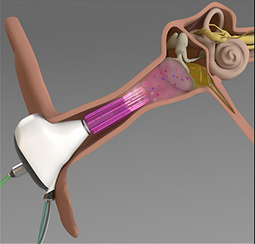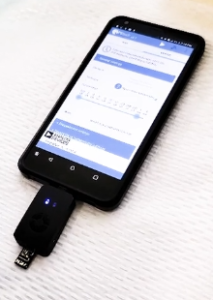Zapping ear infections, disappearing pacemakers, arresting pharma “hacks,” and more
30 Jun 2021
Posted by Andrew Kantor
Walmart-brand insulin
One way to make sure insulin prices get or stay lower: Make your own. Or in the case of Walmart, hire Novo Nordisk to make it for you and your customers. The retailer has struck a deal to offer its customers with insulin analog vials and pens at a deep discount.
The vials will retail for $72.88 and the FlexPens for $85.88, which will save consumers between 58% and 75% off of the cash price for other insulin products […] That equates to savings of up to $101 per branded vial and $251 per package of branded FlexPens.
MRSA roasting on open chestnuts (or something like that)
In parts of Italy, chestnut leaves are used as a traditional remedy for infections. And when they hear “traditional remedy,” smart folks think “There may be something to that.” In this case, the smart folks are Emory University researchers — led by medical ethnobotanist Cassandra Quave* — who have isolated a molecule from the leaves of the European chestnut tree that seems to do a bang-up job killing MRSA.
“We were able to isolate this molecule, new to science, that occurs only in very tiny quantities in the chestnut leaves. We also showed how it disarms Methicillin-resistant Staphylococcus aureus by knocking out the bacteria’s ability to produce toxins.”
Bonus: The team used Lego Mindstorms to build the separator for the compounds in the leaves.
* I’m not sure what’s cooler, her title or her name
Boosters: Now or later? Or never?
So, back to the subject of boosters. The CDC is saying that boosters won’t be necessary until we start to see immunity wane. Could be a year after vaccination, could be 18 months, could be never.
Pfizer, which, you know, makes the shots, says ‘No no no, we’ll need to give out those boosters 8-12 months after vaccination, just to be sure.’
The CDC (specifically its Advisory Committee on Immunization Practices) says that even if antibodies decline, that doesn’t mean that symptomatic disease quickly follows, so, you know, just chill, Pfizer.
Synchronized swimming
If you’ve ever tried riding a tandem bike — or having sex on a half-filled waterbed — you know that synchronizing motion is important. Turns out the same is true for sperm: “If the head and tail of the sperm aren’t moving together, the sperm isn’t going to move efficiently enough to get to the egg.”
University of Toledo (Ohio, not Spain) discovered that such synchronicity isn’t always the case, which would be sperm that didn’t do its job. Knowing what to look for, now, they think could lead to “innovative avenues for diagnostics and therapeutic strategies for male infertility.”
“Right now, people don’t know what to fix. We can pinpoint the problem. This knowledge allows us to identify a subgroup of infertile men that was not revealed before.”
Watch as I make this pacemaker disappear
For that brief period after open-heart surgery, or while waiting for a transplant, heart patients sometimes need a pacemaker. And then they don’t. But instead of having to remove it when it’s not needed, Northwestern researchers came up with a better idea: Make it dissolve.
They’ve created what they call the first ever transient pacemaker — “a wireless, battery-free, fully implantable pacing device that disappears after it’s no longer needed.” It gets power from the outside via radio, and the components biodegrade and are absorbed by the body in a month or two. And the pacemaker is just the start:
“The bioresorbable materials at the foundation of this technology make it possible to create whole host of diagnostic and therapeutic transient devices for monitoring progression of diseases and therapies, delivering electrical, pharmacological, cell therapies, gene reprogramming, and more.”
Now hear this
Drugs for middle-ear infections only work about 70 percent of the time, so the next obvious step is to blast the infection with a plasma gun. If you’re an engineer at the University of Illinois, that is.
So far they’ve only tested their “microplasma jet array” on rats, but they think it will work just as well on humans. Testing is ongoing.
“We used different duration times for the treatment and found that 15 minutes and longer was effective in inactivating the bacteria […] We also monitored the tissue to see if we had created any holes or ruptures, but we didn’t find any obvious physical damage.”

And I was proud of my homebuilt computer
University of Virginia medical researchers are building a mouse from scratch. Essentially, they figured out how to take a bunch of stem cells and instruct them: “Make a mouse.” The difference between this and similar stories is that they’ve created more than just a standalone organ — it’s a set of them, connected.
It is the first in vitro model of a mammalian embryo with so many tissues to be built from stem cells […] Most importantly, those structures are organized as they should be, around the notochord (the precursor of the vertebral column), a defining trait of vertebrate animals.
The idea is to gain a better understanding of how stem cells differentiate, and someday lead to … well, who knows? New drugs, new organs, and maybe even a very different kind of Build-A-Bear Workshop.
A step closer to Star Trek
A prototype sensor developed in Canada can, when connected to an Android smartphone, detect infections in minutes without sending samples to a lab. That means not only quicker and more-targeted treatment (when there is an infection), but also less prescribing of unnecessary antibiotics “just in case.”
It’s going to mean that patients can get better treatment, faster results and avoid serious complications. It can also avoid the unnecessary use of antibiotics, which is something that can buy us time in the battle against antimicrobial resistance.”

Medical smarts
You’re not using plain old-fashioned bandages on a wound, are you? They’re so … boring. What you want is a “smart wound dressing” that glows (under UV light) if the wound becomes infected. Lucky for you, Aussie engineers were on the job.
The dressing they created not only detects infection, that infection is less likely because the bandage itself is antimicrobial. That’s thanks to the magnesium part of the “fluorescent magnesium hydroxide nanosheets” it’s made of. Magnesium works as well as silver, but it’s a lot less expensive.
The Long Read: Bleach edition
The story of “Operation Quack Hack” and the “church” in Florida selling the “Miracle Mineral Solution” cure-all that did nothing of the sort.
Includes fake miracle cures, the Colombian military, an early-morning FBI raid, with shout-outs to Donald Trump, the “church” of Scientology, Ugandan missionaries, and oh so much more.
Inside a steel warehouse on the church’s property, a hazmat crew seized more than 50 gallons of hydrochloric acid and 8,300 pounds of sodium chlorite, which could be combined to make chlorine dioxide, the main ingredient in MMS. FDA investigators affixed stickers reading “1496” to the blue plastic barrels of sodium chlorite, indicating its classification as a chemical so corrosive it can burn a hole through the throat, perforate the stomach, and cause blindness.


